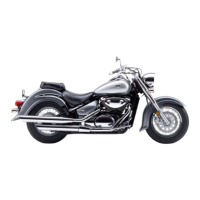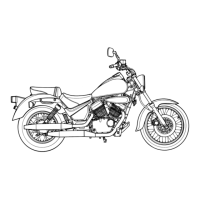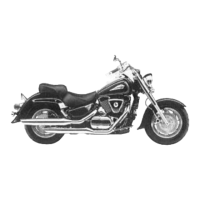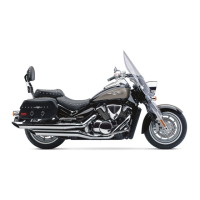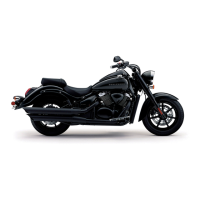2-22 PERIODIC MAINTENANCE
Overhaul the engine in the following cases:
* Compression pressure in one of the cylinders is less than 900
kPa (9 kgf/cm
2
, 128 psi).
* The difference in compression pressure between any two cyl
inders is more than 200 kPa (2 kgf/cm
2
, 28 psi).
* All compression pressure readings are below 1 100 kPa (11
kgf/cm
2
, 156 psi) even when they measure more than 900 kPa
(9 kgf/cm
2
, 128 psi).
COMPRESSION TEST PROCEDURE
NOTE:
* Before testing the engine for compression pressure, make sure
that the cylinder head nuts are tightened to the specified torque
values and the valves are properly adjusted
* Have the engine warmed up before testing.
* Make sure that the battery is fully-charged.
Remove the related parts and test the compression pressure in
the following manner.
• Remove the fuel tank. (!5-3)
• Remove all the spark plugs. (!2-4)
• Install the compression gauge and adaptor in the spark plug
hole. Make sure that the connection is tight.
• Keep the throttle grip in the fully opened position.
• Press the starter button and crank the engine for a few sec-
onds. Record the maximum gauge reading as the cylinder com-
pression.
• Repeat this procedure with the other cylinders.
( 09915-64510: Compression gauge set
09915-63210: Adaptor
COMPRESSION PRESSURE CHECK
The compression pressure reading of a cylinder is a good indicator of its internal condition.
The decision to overhaul the cylinder is often based on the results of a compression test. Periodic mainte-
nance records kept at your dealership should include compression readings for each maintenance service.
COMPRESSION PRESSURE SPECIFICATION
Standard Limit Difference
1 300 – 1 700 kPa 1 100 kPa 200kPa
13 – 17 kgf/cm
2
11 kgf/cm
2
2 kgf/cm
2
185 – 242 psi 156 psi 28 psi
Low compression pressure can indicate any of the following conditions:
* Excessively worn cylinder walls
* Worn piston or piston rings
* Piston rings stuck in grooves
* Poor valve seating
* Ruptured or otherwise defective cylinder head gasket

